





|
Best
viewed in Internet Explorer 5+ at a screen resolution of 1024 by 768
Pixels
Web-Site designed & maintained by WEB
SOLUTIONS
|
...Miniature Painting...
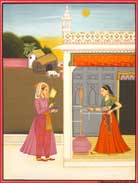 Miniatures
are intricate, colorful illuminations or paintings, small in size, executedmeticulously
with delicate brushwork.
Miniatures
are intricate, colorful illuminations or paintings, small in size, executedmeticulously
with delicate brushwork.
The history of Indian Miniature Paintings can be traced to the 6-7th century AD, the time, when Kashmiri Miniatures first marked their appearance. Miniature Paintings have evolved over centuries carrying the influence of other cultures. The miniature artists gave self-expression on paper, ivory panels, wooden tablets, leather, marble, cloth and walls. Indian artists employed multiple perspectives unlike their European counterparts in their paintings. The idea was to convey reality that existed beyond specific vantage point.
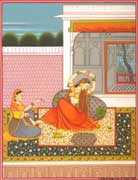 Miniature
Paintings received an impetus in the 16th century under Mughals, Muslim kings
of the Deccan, Malwa and Hindu Rajas of Rajasthan. The rich, colorful miniature
paintings produced under Mughals had strong Persian influence. The paintings
were aristocratic, individualistic and strong in portraiture where the plush
court scenes and hunting expedition of royalty were depicted. Flowers and
animals were also the recurrent images in the paintings. Mughals also commissioned
number of
Miniature
Paintings received an impetus in the 16th century under Mughals, Muslim kings
of the Deccan, Malwa and Hindu Rajas of Rajasthan. The rich, colorful miniature
paintings produced under Mughals had strong Persian influence. The paintings
were aristocratic, individualistic and strong in portraiture where the plush
court scenes and hunting expedition of royalty were depicted. Flowers and
animals were also the recurrent images in the paintings. Mughals also commissioned
number of 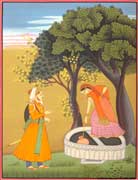 manuscripts
with fine illustrations.
manuscripts
with fine illustrations.
The colors used in the miniatures were derived from minerals, vegetables, precious stones, indigo, conch shells, pure gold and silver. The preparing and mixing of the colors was an elaborate process and it took sometimes, months to get the desired color. Very fine brushes were used for the paintings, which were executed on handmade paper.
Many of the miniature paintings of the period were based on 'Ragas' or musical codes of Indian classical music. The artists personified different ragas in pictorial images conveying a specific mood and sentiment.
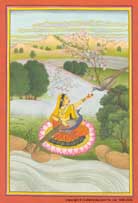 During
the same time, different schools of miniature paintings in Rajasthan flourished
like the Mewar, Bundi-Kota Kalam, Jaipur, Bikaner, Kishangarh and Mewar Schools.
Each of these schools had their unique style and portrayed the images of hills,
valleys, deserts, palaces, forts, gardens, court scenes, religious processions
and the scenes from the life of Lord Krishna (a Hindu God). Unlike Mughul
miniatures the paintings of Rajasthan were simple in their approach and portrayed
scenes of throbbing life around them. The Ragmala paintings and the paintings
based on Ramayana, Geetha Govinda and the Bhagavata Purana are the legacy
of Rajasthan.
During
the same time, different schools of miniature paintings in Rajasthan flourished
like the Mewar, Bundi-Kota Kalam, Jaipur, Bikaner, Kishangarh and Mewar Schools.
Each of these schools had their unique style and portrayed the images of hills,
valleys, deserts, palaces, forts, gardens, court scenes, religious processions
and the scenes from the life of Lord Krishna (a Hindu God). Unlike Mughul
miniatures the paintings of Rajasthan were simple in their approach and portrayed
scenes of throbbing life around them. The Ragmala paintings and the paintings
based on Ramayana, Geetha Govinda and the Bhagavata Purana are the legacy
of Rajasthan.
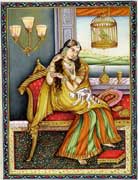
In the 17th-19th centuries the Pahari school of painting started flowering
in the hill states of Northern India namely in the regions of Basohli, Guler,
Kangra,Mandi, Nurpur, Bilaspur, Manali Kullu and Bilaspur . Though influenced
by the Mughul and Rajasthani traditions Pahari School developed its distinctive
style. The Kangra School emerged noticeably in the 18th century, and exhibited
verdant settings of the Kangra valley and the legends from Lord Krishna's
life. The female figures were rendered with grace and charm. The 'Sikh School'
formed the last phase of Pahari miniatures.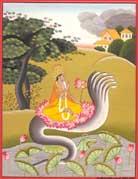
The Kashmir school of miniature resurged in the l9th century and found expression in the Sharada manuscripts, horoscopes, folk-art works like the krula pacch, nechipatra (almanac) etc. besides individual paintings.
The miniature artists faced hardships after they lost the patronage of the royalty, due to the changed political equations. Today, it is a dying art form as many of the artists have embraced other professions.
The classic miniatures of the yore are preserved in museums. However, reproductions of these miniatures are also available that can be made a part of private collection.